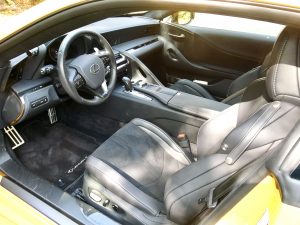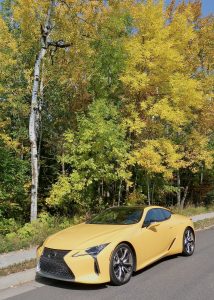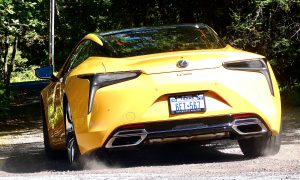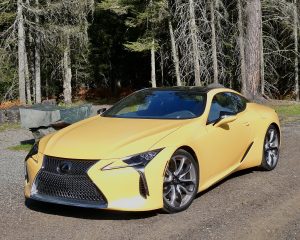Bright leaves no match for Lexus LC500
By John Gilbert
The timing was perfect, although it’s difficult to think of a bad time for a week-long test drive of the 2020 Lexus LC500 Coupe. The LC500 is one of the most strikingly beautiful car designs on the market, but the perfect timing was explained because we beat any threat of early snow around our Duluth location on Lake Superior’s North Shore.
The LC500 comes with rear-while drive, and while the latest traction-control gizmos all work impressively, I would rather drive it in dry or wet conditions, and I prefer front-wheel drive or all-wheel drive when the roadways get icy. Besides, the timing included catching the foliage throughout Northern Minnesota at nearly peak change of colors, with the bright golds, reds and oranges replacing the summertime’s green leaves.
The LC500 arrived wearing “Flare Yellow,” a new Lexus color this year, with a highly metallic base and a brilliant yellow that made even the brightest trees look a little less bright. I often admire yellow cars when other people buy them, but it’s not my personal favorite. I might, however, have to re-evaluate to make an exception with the LC500, because of the constantly positive reactions we got while driving around. We became a regional attraction without intending to be, just because of that car in that color.
It is loaded with all the latest electronic gadgets and features, and as the top of the Lexus line — which is altogether at the top of the Toyota line — the LC500 is the pinnacle. Base price is $92,950, which seems reasonable after all the options on the test car raised the ante to $106,440.
On the bright Saturday morning of our Lexus week, my wife, Joan, and I wanted to hit our area Farmer’s Market for the peak of the delectable harvest. Then we’d make a stop at Target, and then take some less-busy highways north for a scenic drive to the Iron Range. Joan went into Duluth’s Target store, as I parked in an obvious spot near the entrance, to listen as the Minnesota Twins battled through one of the final games of their abbreviated regular season. I noticed that nearly everybody walking past gazed at the car so regularly that I had to affect a nonchalant demeanor.
A young guy walking back to his car angled diagonally to approach my open window, and said, “Sorry to bother you, but — great pick! That is an absolutely beautiful car.” I smiled and thanked him, without time to explain that it wasn’t my car.
We started toward the highway, and as another car passed us, a kid in the passenger seat yelled, “I like your car, man!”
That became a pattern of admiring comments attracted by the LC500, and its Flare Yellow paint job.
It is not just the paint that attracts attention. The sweeping roofline that connects the busy but distinctive signature spindle grille up front, all the way back to the neatly shaped collection of vents and contours that comprise the rear, come together to make the LC500 the most perfect example of how a manufacture can combine the best attributes of a traditional sports car and the comparatively exotic design of an exotic sports car.
For the LC500 to accomplish that feat in the Toyota-Lexus stable is noteworthy, because during its obvious changeover in styling and performance to modernize the company, there are several startling new sports cars, including Toyota’s own Supra, and assorted other Lexus coupes. I find the new Supra to be interesting, but I think the LC500 is more attractive. Maybe that’s the traditionalist in me coming out, but this is a design that would dazzle owners of a Corvette, Porsche, of even an Italian sports car.
Its performance meets all requirements, too. It comes with a 5.0-liter V8, with dual-overhead camshafts, high-tech variable valve timing, and a 10-speed automatic with large magnesium steering-wheel paddles. It develops 471 horsepower with 398 foot-pounds of torque, which is plenty to make you overlook the heft that helps keep the low-slung Lexus planted.
It also has some technical tricks to help you maneuver through traffic or twisty curves without any concerns. It has an adaptive exhaust that resonates on call. And adaptive variable suspension and adaptive rear-wheel steering that guides you around curves with greater precision but without any perceptible feeling of complexity.
As fun as the LC500 is to drive, from those specially formed sport bucket seats, the biggest concern you have is to keep your eye on your speed, unless you would like your Flare Yellow to attract any assorted highway patrolmen, police, or sheriffs in the region. That is not as simple as it sounds, either, because the car accelerates in a flash, and when you glance down, you have to be disciplined to readily spot the digital speed number imbedded in the large and prominent tachometer.
You can alter the location of the big gauge and other ancillary features, but I came up with a nitpick in the process. With 10 speeds, and so much power, you are turning only about 1,700 RPMs on the tach when cruising at 65 or so. In other words, unless you are in sport or sport-plus settings and feeling racy, you aren’t about to over-rev it so there really is no critical need to keep watching your revs, compared to the urgency with which you want to spot the speed at a glance.
That is a minor point, although there are a couple of other nuisance items with the car — and it’s always appropriate to point them out when there is so much to gush over. Clean and sweeping as the shape and design are, the complexity of trying to tune the audio system is somewhere beyond my common sense, as well as my tolerance level. You can’t seem to simply get a panel on the screen with preset stations, which you might alter up or down with ease. It takes more attention than it deserves to make such a simple change.
The LC500 also refused to let me do the simple Bluetooth programming of my iPhone into the audio system, which is a distinct safety feature. After one frustrating attempt, I gave up, and went out the next day to dedicate a half-hour to this electronic wrestling match, trying to connect. It kept notifying me that there was “no phone connected” each time, and at the peak of my frustration, the in-car phone rang. I pushed the accept button, answered it, and it was my wife, Joan! She called to see what was taking me so long, and I had to tell her I couldn’t hook up the phone. “But you’re on your phone, aren’t you?” Hmmm. Yes. Indeed, the phone connection it refused to give me was working and had connected me, it just kept telling me it wasn’t connecting, as if it wanted to keep it a secret.
Forget all that stuff. We thoroughly enjoyed our drived to Virginia, Minnesota, which allowed us to stop at Canelake’s Candy shop. Renovated to feature the original fountain from nearly a century ago, we picked out stools at the old-fashioned fountain, with Joan revisiting her youth with a soda, while I settled for a turtle sundae. Afterward, we drove through town and into neighboring Eveleth, just to make sure the 50-foot hockey stick was still in place downtown.
Back on Highway 53, headed south, we saw a small sign indicating the memorial site for the late Minnesota senator Paul Wellstone. We drove the few miles east to near the site where he died in a 2002 plane crash, just a week or two before what we assumed would be the certain re-election of one of the state’s most popular senators. We spent quite an emotional while on the walk paths admiring the trees, and reading the biographical signs along the way.
We got back on Hwy. 53 and started discussing dinner. I made a suggestion that was an easy one: We were at the shortcut west off Hwy. 53 to Hibbing, where we could stop at the original Sammy’s Pizza, the birthplace for the legendary Duluth pizza chain. To celebrate a wonderful day, we ordered sausage, onions, green peppers and sauerkraut, and it was a delicacy. As we sat near the window, we could watch every passerby across the street stop and gaze at the Flare Yellow Lexus LC500.
Lots of attention, lots of style, lots of pending excitement, and yes, lots of money. But we were the ones in town who were able to climb inside and head on home in such a special vehicle.







 John Gilbert is a lifetime Minnesotan and career journalist, specializing in cars and sports during and since spending 30 years at the Minneapolis Tribune, now the Star Tribune. More recently, he has continued translating the high-tech world of autos and sharing his passionate insights as a freelance writer/photographer/broadcaster. A member of the prestigious North American Car and Truck of the Year jury since 1993. John can be heard Monday-Friday from 9-11am on 610 KDAL(www.kdal610.com) on the "John Gilbert Show," and writes a column in the Duluth Reader.
John Gilbert is a lifetime Minnesotan and career journalist, specializing in cars and sports during and since spending 30 years at the Minneapolis Tribune, now the Star Tribune. More recently, he has continued translating the high-tech world of autos and sharing his passionate insights as a freelance writer/photographer/broadcaster. A member of the prestigious North American Car and Truck of the Year jury since 1993. John can be heard Monday-Friday from 9-11am on 610 KDAL(www.kdal610.com) on the "John Gilbert Show," and writes a column in the Duluth Reader.